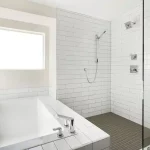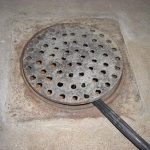If you’ve ever experienced water dripping through your basement shower drain, you know it’s not a good sign. It can be frustrating and even raise your blood pressure, knowing that something is wrong with your basement shower drain. Leaks in the basement shower drain can occur due to several reasons, including a damaged drainpipe, a cracked gasket, leaks around the shower faucet, and flange. It’s important to identify the exact cause of the leak and fix the problem to prevent further damage.
In this article, we’ll help you find the reason and solution for a leaky basement shower drain. We’ll go over the common causes of basement shower drain leaks and provide you with tips on how to fix the problem. Whether you’re a homeowner or a renter, understanding the causes of basement shower drain leaks can help you save time and money in the long run.
The Reasons for Basement Shower Drain Leakage:
Cracks in the Drain Gasket:
When you use your shower frequently, the rubber gasket between the shower pan and drain pipe can become damaged, leading to a leaky shower drain. The rubber gasket creates a watertight seal between the two components, and if it fails to do so, water will start dripping around the basement. Check the gasket immediately if you notice any leaks.
A Broken Shower Pan:
A broken shower pan can also cause a leaky basement shower drain. To check for cracks or damages, fill the shower pan with water and remove the cover plug. Inspect the shower pan carefully, and if there are any cracks, the water level will drop, and water might start going through the damaged sections. Wait for a few minutes for the inspection, as the water from the shower pan will take time to travel the distance.
Leaks in the Drain Pipe:
The drain pipe connecting the shower drain with the main drainage of your home through the basement can also be the primary reason for leakage in basement shower drainage. If the drain pipe gets damaged or cracked, water will pass through the pipe, causing a leaky shower drain. Inspect the drain pipe through the wall for any dampness or leaks, and change the pipe if necessary.
Leaks in the P-trap:
The P-trap is responsible for keeping water in the shower drain when the shower is not in use and preventing smelly gas from the sewage system from entering your home. Due to oldness or overuse, the P-trap can also get damaged, leading to a leaky basement shower drain. Inspect the P-trap system and drain pipe, remove any moisture and residues, and check if they are working properly.
Leaks in Shower Faucet and Drain Flange:
If you don’t find any leaks in the drain pipe and P-trap, check the shower faucet and drain flange. A loose shower faucet can cause water to slowly run through the main supply pipe, leading to a leaky basement shower drain. The drain flange, which overlaps the shower pan, can also be damaged and cause leaks. Check the watertight seal of the flange by filling the shower pan and plugging in the drain.
Cracked Tiles in the Bathroom:
Damaged tiles in your bathroom can also cause water to leak through the basement shower drain. When one or multiple tiles are damaged, water can slowly pass through the damaged tiles, making your subfloor wet and causing water to start dripping through the subfloor to the basement. Check your bathroom tiles for any cracks or damages to prevent a leaky basement shower drain.
Tips On Fixing the Leaks in Basement Shower Drain
Replacing the Drain Gasket:
If your basement shower drain is leaking due to a damaged drain gasket, you can fix it easily by replacing it. To get the right size, take the old gasket to the hardware store and buy a new gasket of the same size. Once you have the new gasket, attach it to its place.
Fix the Drain Pipe and P-trap:
If the leak is caused due to a cracked P-trap or drain pipe, you can repair it by tightening the ring nut. Use an adjustable wrench to tighten the ring nut of the P-trap. If the leak continues, you will have to replace the entire P-trap system. Remove the locking nuts and hold the drain water in a container. Thread in the drain pipes through both ends of the P-trap and tighten the locking nuts. Apply Teflon tape on the leaky point for the drain pipe to fix it temporarily. You might need to change the drain pipe with a plumber’s help.
Fixing the Shower Pan:
When the shower pan is damaged and causing leaks, you need to replace it. Look for plastic or fiberglass shower pans instead of ceramic pans to reduce costs. In most cases, the cracks are tiny enough to be repaired with a plumber’s putty or acrylic repair kit. Clean the area to stick to the acrylic repair kit on the surface. Use a putty knife to apply the acrylic element on the shower pan cracks. Look at the user manual of the acrylic kit to know if it needs any hardener. If it asks you to use a hardener, you need to apply it.
Fixing Shower Flange and Drain Gasket:
If the gasket or shower flange is causing damage, you need to replace it. Remove the older gasket, get the exact size, and replace it. For the shower flange, unscrew it and then replace the new one. Don’t forget to tighten the screws of the shower flange.
Replacing the Bathroom Tiles:
If your bathroom tiles are causing leakage, we suggest you call a plumber or tile worker for it to avoid further consequences. If you damage the subfloor, it will be truly costly. Regular maintenance of the shower drain can help prevent leaks. You can use a drain snake or plunger to remove any blockages in the drain opening. Use a water-based silicone seal or caulk to reseal the shower base and cover plate. Wear gloves and use a bucket to catch any water that may come out during the repair process. Use channellock pliers or needle-nose pliers to loosen or tighten the joint or compression fitting. Apply grease or friction washer to make it tight. Ventilation is essential during the repair process.
Frequently Asked Questions:
Why is your shower leaking around the drain?
If you are experiencing a leak around your shower drain, it may be due to a cracked shower gasket, flange, or P-trap. These issues can occur due to age, wear and tear, or improper installation. To fix the issue, you may need to replace the damaged part or reseal the area around the drain. It is recommended to hire a professional plumber to properly diagnose and fix the issue.
How much does it cost to fix a leaking shower drain?
The cost to repair a leaking shower drain can vary depending on the cause of the leak. Replacing a rubber gasket can cost around $25, while replacing a damaged shower pan can cost over $250. On average, you can expect to pay between $50 and $600 for a professional to repair the issue. Be sure to check with your insurance provider to see if the repair is covered under your policy.
Final Words
Now that you have a better understanding of why your basement shower drain may be leaking, you can take the necessary steps to prevent it from happening again. Remember to regularly clean your drain to prevent any buildup that may cause leaks and to check for any cracks or damage in the drain itself. If you do notice any issues, don’t hesitate to contact a professional plumber like James Martin to help you fix the problem. By taking these simple precautions, you can maintain your basement and shower drain in good condition, which can increase the value of your property.





